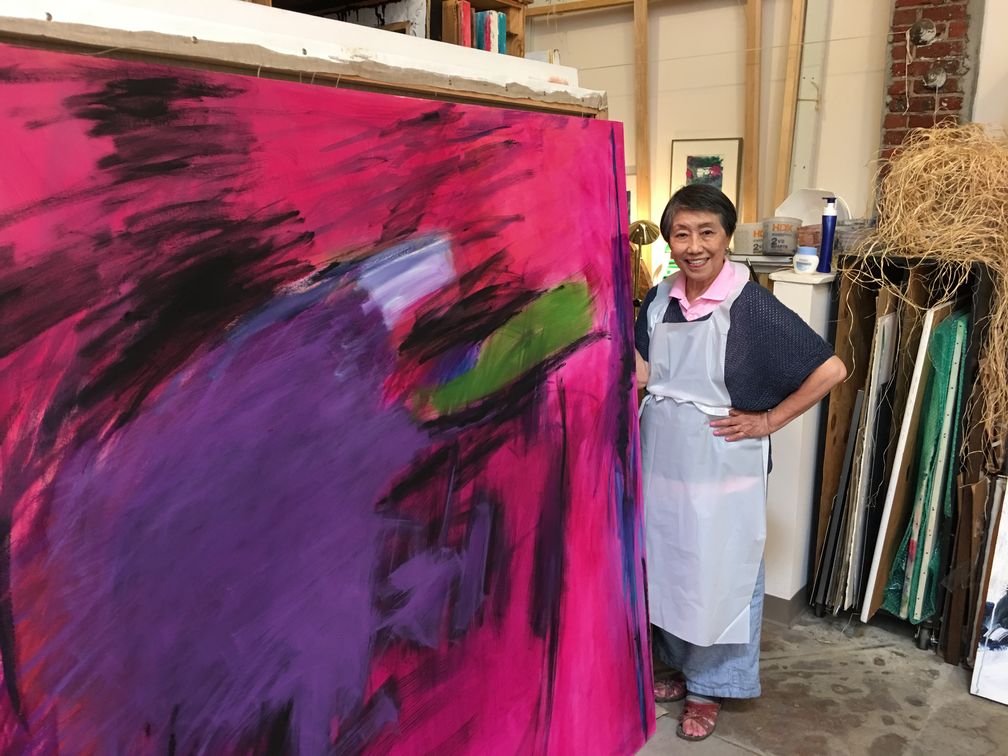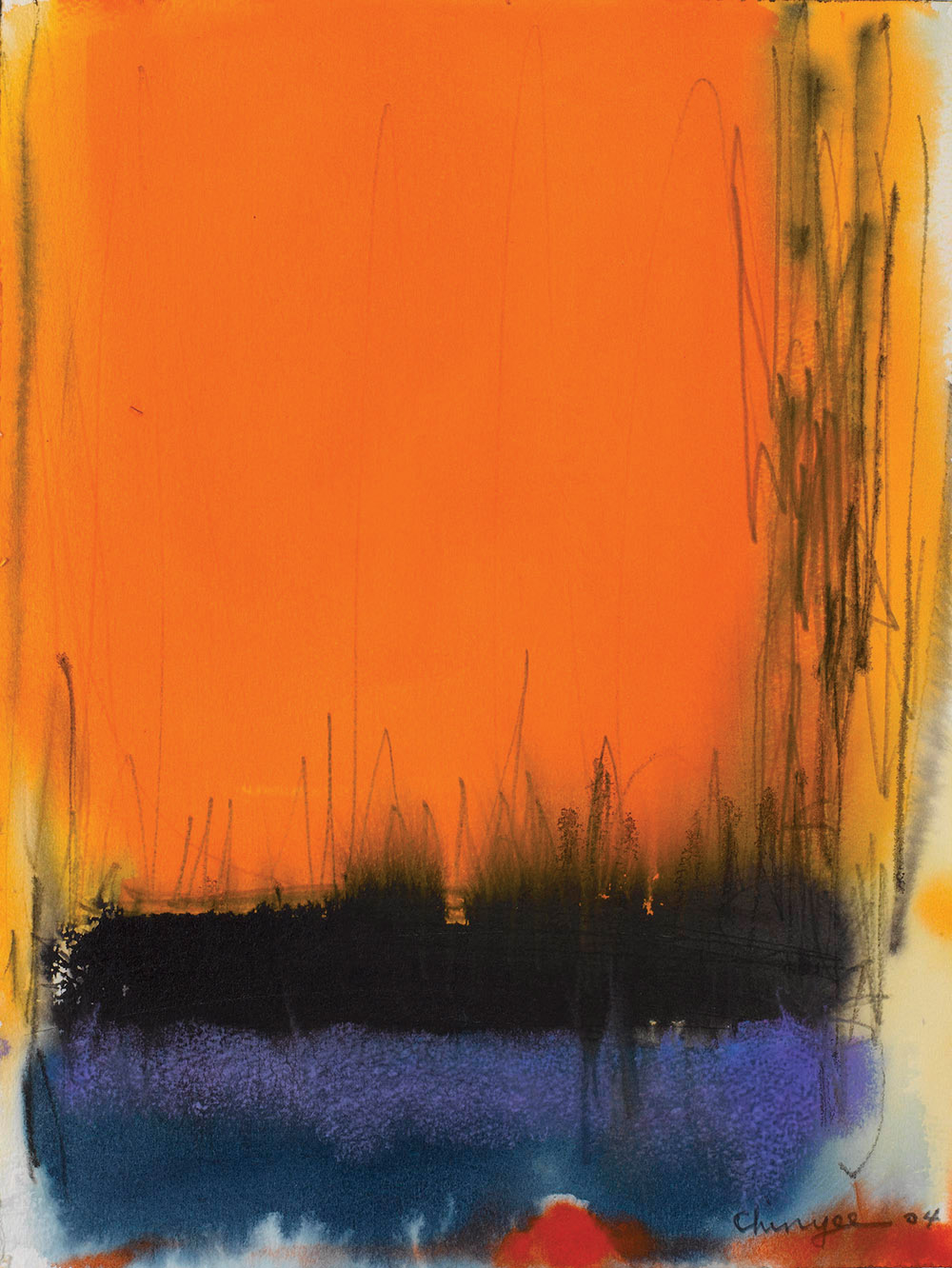People
Living Color: Profile of Chinyee


Raspy, trumpeted notes dip, jump and shimmy across a melodic scale, meandering spontaneously through a supporting rhythmic foundation of brassy hi-hats, double bass twangs and piano progressions. So begins Miles Davis’s legendary 1959 jazz album Kind of Blue—nonagenarian painter Chinyee’s one and only requisite studio soundtrack for the past decade. Improvised jazz, with its associations of subversion and liberation, was deeply evocative for numerous 20th-century artists, including abstract expressionist Jackson Pollock, minimalist Frank Stella, and
neo-expressionist Jean-Michel Basquiat. Dubbed a “lyrical abstractionist” by critics, Chinyee is similarly partial to the
musical genre.
Like many of the other canvases in her solo exhibition “Dances of the Inner Being,” presented by Hong Kong’s Alisan Fine Arts, Natural Motion (2018) reflects the influence of jazz on the artist. Rendered in black oil pigment, what begins as a determined upward stroke then zigzags horizontally towards the right edge of the canvas, becoming increasingly wispy as the brush was dragged brusquely across the surface, before doubling back on itself and making a dash for the opposite end. Mirroring Davis’s rolling melodies, the composition is dynamic and uninhibited; yet, in the repeated gestures that created the lines, it also adheres to a rigorous logic.


When we met before the opening of the show, Chinyee explained to me her criteria for a “good work”: a balanced composition, complementary colors that create both harmony and conflict, and bold brushwork. The exhibits in “Dances of the Inner Being” could all be seen as the artist’s attempts at piecing together this three-tiered puzzle that she has designed for herself. Chinyee begins with a single, continuous gesture—as in the series of sharp peaks and valleys in Natural Motion—and from there, like a one-person jazz ensemble, her challenge is to create corresponding elements that enhance the effects of the work’s existing components. Though she doesn’t mix her own hues, color is of particular importance; often, the pigments that she has picked out will dictate her moves. For example, in April (2018), vertical strokes of azure blues are layered atop a buttery light yellow from opposite the color wheel, and are in turn partially obscured by a tornado of horizontal, deep blue scrawls. A small patch of vibrant orange served as the artist’s final touch to offset the dominance of the blues. A single smear of lime green in the hot pink Longings (2013) and a potent dab of red in the white-and-blue Indigo A (2018) function in similar ways.
It took Chinyee many years of experimentation and the observation of both her own and other artists’ practices to come to such an approach for a “good work.” Born in 1929 in Nanjing, Chinyee spent her early years fleeing the chaos of the Sino-Japanese war. In 1937, her family settled in Chongqing and she was sent to the prestigious Chongqing Private Nankai Middle School (then known as the Nanyu Middle School), where she attended her first formal art class. There, she was taught Western painting and drawing techniques in addition to traditional Chinese art and calligraphy, and was given resources such as reproduced images of Euro-American paintings. In 1947, seeking refuge from the Chinese Civil War, which had escalated after World War Two came to an end, she took up a scholarship to complete a Bachelor of Fine Arts degree at the College of Mount Saint Vincent in New York. Her reasons for pursuing art were mostly practical: she had wanted to study Chinese literature, but that did not come with a scholarship to the United States. Her next best option was art, a universal language, which she had enjoyed and found easy enough to understand during her high school years.
After finishing her undergraduate studies and still unable to return to China, Chinyee enrolled herself at New York University, where she attained her Masters in Art Education in 1953. Unexpectedly exiled from her birth country and separated from family, she was tremendously homesick. Because of this and her supervisors’ encouragement, she created mostly figurative ink works during this period, drawing heavily from the motifs of traditional Chinese paintings and poetry. Scenes such as a moon hanging in a vast night sky and lotuses emerging from ponds would remain visible in her oeuvre until the 1990s. In 1965, the artist presented her first solo exhibition at Mi Chou Gallery in New York—the only local commercial platform dedicated to Chinese artists at the time. In preparation for the show, she worked throughout the night and in the spare hours that she had when she wasn’t working as an accountant at the United Nations.

Though she had taken up the full-time job to sustain herself, Chinyee remained dedicated to her artistic practice, regularly setting aside weekends to advance her painting. Gradually, she was propelled towards abstraction by the activities of the New York School. The importance of Mark Rothko’s paintings to Chinyee’s practice can be seen in her works such as the “Beyond My Window” series (circa early 1990s to the early 2000s). Despite being purportedly based on the titular subject, the canvases, divided horizontally into rectangular fields of color that bleed into one another, bear an undeniable resemblance to Rothko’s works. Chinyee’s approach to abstraction, like that of painter Robert Motherwell, was also shaped by the principles of traditional Chinese ink painting and calligraphy, according to which, the goal of two-dimensional representations should be to convey the essence of a subject, not to reproduce an accurate likeness. Chinyee recounted harnessing her incisive observational skills during her various international missions with the United Nations in the 1960s, after she had moved into the role of Chinese interpreter. For example, during a sojourn in the Congo, she enticed the local children to sit for portraits by offering them sweets. Working rapidly in a sketchpad, she would capture their expressions with confident and dynamic lines—the very same marks that can be seen in her later abstractions and even her recent paintings.
Now based in New Jersey, Chinyee spends all of her time pursuing the perfect composition, color combination and brushwork. As the explosions of color and frenetic gestures in her works evidence, she derives the same joy from painting as she did over half a century ago, and she has no plans of stopping.
Chloe Chu is ArtAsiaPacific’s associate editor.
To read more of ArtAsiaPacific’s articles, visit our Digital Library.









